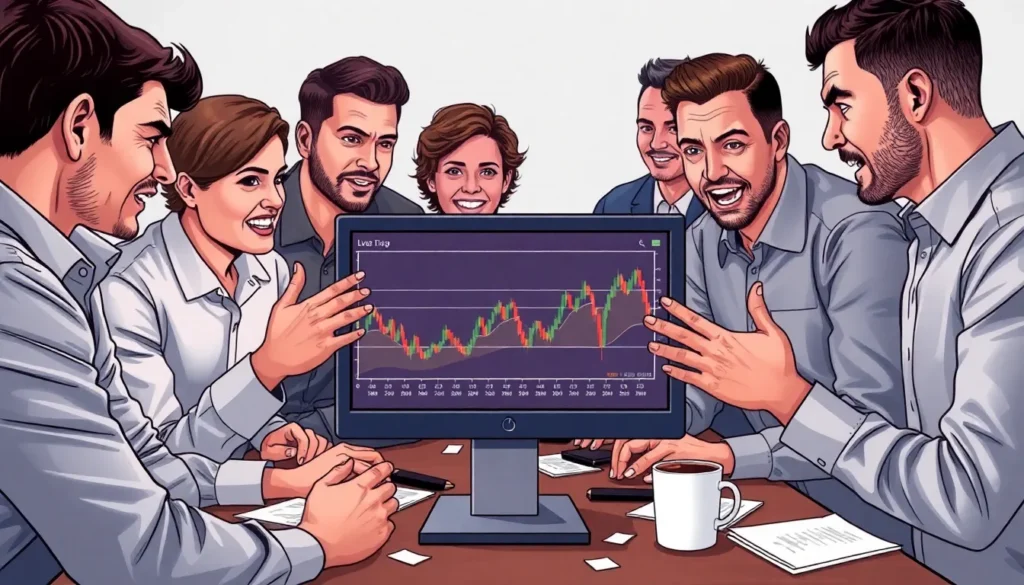In the wild world of cryptocurrency, bubbles are as common as memes featuring cats in sunglasses. These digital assets can skyrocket in value faster than a rocket-powered hamster, leaving investors both thrilled and terrified. But what exactly are crypto bubbles, and why do they seem to inflate and burst with the regularity of a bad sitcom?
Crypto Bubbles
Crypto bubbles represent periods of excessive market speculation, resulting in inflated asset prices. Extremes in investor enthusiasm often create these bubbles, driving prices far beyond rational valuations. During these times, many U.S. investors experience both excitement and anxiety as cryptocurrency values change rapidly.
Investors typically enter the market during euphoric phases, drawn by stories of rapid wealth accumulation. Speculative behavior often leads to rising prices, attracting even more interest. Prices peak when fear of missing out escalates, encouraging people to invest without fully understanding the underlying technology.
Once the bubble reaches a certain height, it inevitably bursts, sometimes leading to steep declines in value. Many investors panic at this point, leading to a mass sell-off and further exacerbating price drops. Historical data illustrates that major cryptocurrencies, like Bitcoin and Ethereum, have faced severe corrections following bubble bursts.
Recognition of the signs of a crypto bubble provides valuable insight for investors. Notable indicators include skyrocketing prices without increased adoption or innovation. Community sentiment often shifts from optimism to skepticism as values fluctuate dramatically, showcasing the volatility inherent within the market.
Investors play a critical role in these cycles and can influence market dynamics significantly. Monitoring social media trends, market analyses, and news reports helps provide context regarding ongoing fluctuations. By acknowledging the cyclical nature of crypto bubbles, investors can make informed decisions and navigate risks more effectively.
Historical Examples of Crypto Bubbles

Crypto bubbles illustrate the volatile nature of the cryptocurrency market. Examining past instances reveals patterns of speculation and rapid value changes.
2017 Bitcoin Surge
In 2017, Bitcoin’s price skyrocketed from about $1,000 in January to nearly $20,000 by December. This exponential growth attracted massive media attention and new investors eager to profit. Excitement about blockchain technology and potential returns fueled this surge. Although this rally showcased the cryptocurrency’s appeal, it also highlighted the dangers of speculative investment. The bubble eventually burst in early 2018, leading to a decline of over 80%, with prices dropping back to $3,000.
ICO Craze of 2018
The initial coin offering (ICO) boom in 2018 marked another significant crypto bubble. More than 1,400 ICOs raised around $7 billion, driven by investor enthusiasm for new token projects. Many investors overlooked due diligence in favor of quick gains, focusing on trends rather than fundamentals. This speculative frenzy attracted numerous scams and unviable projects, compounding the risk. By late 2018, the majority of these ICOs had plummeted, resulting in substantial financial losses for many.
Causes of Crypto Bubbles
Crypto bubbles arise from various interconnected factors that contribute to the volatile nature of the cryptocurrency market.
Speculation and Hype
Speculation fuels crypto bubbles when investors chase potential profits without solid fundamentals. Hype amplifies this phenomenon, as media coverage and social media discussions create excitement around specific cryptocurrencies. Investors often flock to assets based on trends rather than data, resulting in inflated prices. The allure of quick gains attracts newcomers to the market, driving further speculation. Price surges often become self-fulfilling prophecies, where rising values entice more investment, perpetuating the bubble. Historical examples highlight that strong narratives about technology or potential often propel these speculative cycles.
Market Psychology
Market psychology plays a critical role in forming and sustaining crypto bubbles. Emotional reactions such as greed and fear significantly influence investor behavior. Many traders feel buoyed by bullish trends and invest heavily, expecting continued price increases. Conversely, panic sets in when a bubble bursts, leading to widespread sell-offs. Shift in sentiment often occurs rapidly, driven by news events or influential figures in the industry. Validating emotions through social media can amplify both positive and negative market reactions, intensifying price swings. Understanding these psychological dynamics allows for better risk assessment during volatile periods.
Consequences of Crypto Bubbles
Crypto bubbles yield significant consequences that impact investors and the broader market. Financial losses and regulatory responses often dominate discussions surrounding these phenomena.
Financial Losses
Investors frequently encounter substantial financial losses during and after crypto bubbles. The rapid price increases can create a false sense of security, prompting many to invest heavily. Once the bubble bursts, they face steep declines; for instance, Bitcoin’s value dropped from nearly $20,000 to about $3,000 within a year after its 2017 peak. Individual investors often suffer the most, with many losing life savings or substantial portions of their portfolios. Such situations lead to a substantial shift in investor confidence and can deter future investments in cryptocurrencies. As history demonstrates, maintaining a cautious approach amidst soaring prices is crucial for avoiding significant losses.
Regulatory Responses
Regulatory bodies frequently respond to the aftermath of crypto bubbles, often enacting stricter policies or guidelines. Governments may introduce regulations aimed at protecting investors from potential fraud and market manipulation. In the wake of high-profile collapses, certain countries have taken action by banning specific cryptocurrencies or initial coin offerings. Regulations can vary greatly by region; for example, the European Union has proposed comprehensive regulations to ensure transparency and security within the cryptocurrency market. Such measures aim to restore investor trust and stabilize the market in the long term. Understanding the evolving regulatory landscape is essential for investors navigating a volatile market.
Preventing Future Crypto Bubbles
Preventing future crypto bubbles requires a combination of education, awareness, and responsible investing practices.
Education and Awareness
Education plays a crucial role in understanding the cryptocurrency market. Investors should familiarize themselves with market fundamentals, including technology behind blockchain and asset valuation. Awareness of historical examples helps identify potential warning signs of bubbles. For instance, noticing when prices surge without corresponding innovation can signal unsustainable growth. Workshops or online courses provide valuable insights into market dynamics. Regularly updated resources allow investors to stay informed about trends and risks. Engaging with credible sources helps build a well-rounded perspective, making it easier to differentiate between sound investments and speculative bubbles.
Responsible Investing Practices
Responsible investing practices mitigate the risks associated with crypto investing. Setting clear investment goals enables better alignment with individual risk tolerance. Investors should diversify their portfolios to reduce exposure to volatile assets. Allocating a small portion of available capital to cryptocurrencies can safeguard overall financial health. Regularly reviewing and adjusting investment strategies ensures alignment with market developments. Moreover, avoiding high-leverage trading prevents excessive losses during downturns. Practicing patience fosters a long-term outlook, reducing impulsive decisions driven by market hype. Each of these strategies promotes a more disciplined approach, helping to create a healthier investment environment.
Conclusion
Crypto bubbles represent a fascinating yet perilous aspect of the cryptocurrency landscape. Understanding their cyclical nature and the psychological factors driving investor behavior is crucial for anyone looking to navigate this volatile market. By recognizing the signs of an impending bubble and adopting responsible investing practices, individuals can better protect their investments and make informed decisions.
As the cryptocurrency market continues to evolve, education and awareness will play pivotal roles in mitigating the risks associated with speculation and hype. Investors who commit to learning about market fundamentals and maintaining a disciplined approach are more likely to thrive in this dynamic environment. Embracing a long-term perspective can ultimately lead to more sustainable growth and a healthier investment climate for all.
